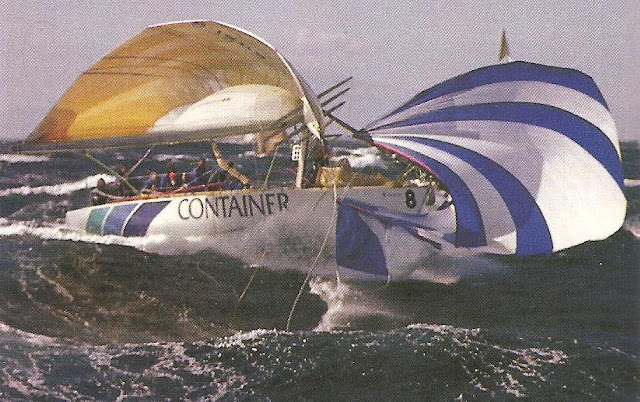 |
| Will sails upwind in fresh conditions during the second race of the Japanese World Cup event, November 1989 (photo Sail magazine) |
 While the event was notable for the impressive size of the fleet, the largest fleet to ever compete in an IFYA event, the conditions in Miura, a commercial fishing village in Sagami Bay south of Yokohama, were less so. Winds swung between very heavy and very light, and the race committee barely got in the minimum four (out of seven scheduled) races to constitute a series. The second race was in the very upper limit for the fragile racers, sailed in breezes that reached a steady 39 knots. Boats surfed at 18 knots. Some limped away early - the Judel-Vrolijk designed Container (helmed by Star sailor Achim Greise) was dismasted in dramatic style during a wayward gybe. The rig was cut away and later retrieved by scuba divers – the crew worked all day and night in watches of seven men to splice the mast together again, and they finished just in time to sail the next day’s races. The overall toll from the race was two broken masts and four broken booms, and a variety of other minor damage.
While the event was notable for the impressive size of the fleet, the largest fleet to ever compete in an IFYA event, the conditions in Miura, a commercial fishing village in Sagami Bay south of Yokohama, were less so. Winds swung between very heavy and very light, and the race committee barely got in the minimum four (out of seven scheduled) races to constitute a series. The second race was in the very upper limit for the fragile racers, sailed in breezes that reached a steady 39 knots. Boats surfed at 18 knots. Some limped away early - the Judel-Vrolijk designed Container (helmed by Star sailor Achim Greise) was dismasted in dramatic style during a wayward gybe. The rig was cut away and later retrieved by scuba divers – the crew worked all day and night in watches of seven men to splice the mast together again, and they finished just in time to sail the next day’s races. The overall toll from the race was two broken masts and four broken booms, and a variety of other minor damage.  |
| Container prepares to gybe in the very fresh conditions in the second race - below, the aftermath |
 |
| Andelstanken leads Will and Windquest in fresh conditions in the second race (photo Sail magazine) |
 |
| Some of the Fifties on their way to Japan |
Sixteen 50-footers went on to compete at Key West in early 1990, where the wind blew harder than the previous year’s event, and well above 20 knots for the first two days. Kobayashki’s new Farr-designed Tiger was the early leader, but a premature start in the seventh race cost her the series. The new Farr designed Springbok ended up winning five races of the series, but remained behind Container in overall World Cup standings.
 |
| The Fifties at Key West Race Week (possibly during 1991) - Carat leads Insatiable, Windquest, Champosa and Springbok (photo by Sharon Green | Ultimate Sailing) |
 |
| The Fifties at Key West Race Week - Insatiable leads Springbok, Carat and Will (photo by Sharon Green | Ultimate Sailing) |
 |
| Close up view of the action aboard Blizzard during the 1990 Key West regatta (photo Sailing World magazine) |
 |
| The Fifties at Key West Race Week - Springbok leads from Carat and Will (photo by Sharon Green | Ultimate Sailing) |
 |
| Container leads Windquest around a leeward mark during the Tortola World Cup regatta (photo Craig Davis/Sail magazine) |
 |
| Container was the early front-runner in the 1990 50-Foot season (photo Diamond Sails) |
 |
| Abracadabra - standout performer during the 1990 World Cup series (photo McConaghy Boats) |
 |
| Abracadabra makes her debut in the Miami World Cup regatta (photo Sailing World magazine) |
 |
| Springbok puts her bow in during a gybe in fresh conditions in Narragansett Bay, Newport (photo Sail magazine) |
 |
| Abracadabra - 1990 World Cup winner (photo McConaghy Boats) |
 |
| Carat VII - fifth in the 1990 50-Foot World Cup, and sporting her Sobstad 'Genesis' mainsail |
 |
| Mandrake was the overall winner in the 1990 Merit Sardinia Cup |
 |
| Mandrake (photo Carlo Borlenghi / Farr Yacht Design Facebook page) |
Article updated May 2024


Good evening at all,
ReplyDeleteI am looking for photo information of this boat:
born free designed by Ron Holland in 1985
thank you for the help you can give me
David